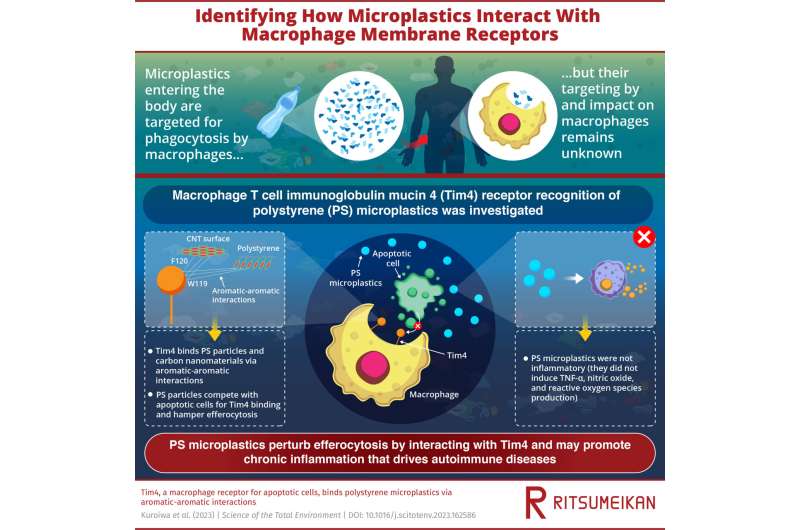This article has been reviewed according to Science X's editorial process and policies. Editors have highlighted the following attributes while ensuring the content's credibility:
fact-checked
peer-reviewed publication
proofread
Scientists shed light on how macrophages interact with microplastics

A large portion of the nearly 200 million tons of single-use plastic produced globally ends up discarded as waste. The eventual breakdown of this plastic into microplastics—0.1–1000 µm-sized particles—is a cause for concern. Humans are exposed to microplastics not only through food consumption but also via inhalation, and their occurrence in the bloodstream and organs has already been documented.
It is unknown if chronic exposure to microplastics impacts human health, but they are targeted for phagocytosis–the process of foreign particle engulfment–by macrophages. Apart from pathogens, macrophages recognize environmental particles like nanomaterials by recognizing patterns in specific parts of targets slated for phagocytosis. While considered bioinert and non-inflammatory, it is not known how macrophages recognize microplastics and how their own function is impacted following microplastic engulfment.
Now, a group of researchers at Ritsumeikan University and Shimane University have shed light on how polystyrene (PS) microplastics interact with macrophages. Their findings were published in the journal Science of the Total Environment.
The research group, led by Professor Masafumi Nakayama from Ritsumeikan University, discovered the role of a previously unknown aromatic-aromatic interface between PS microplastics and the T cell immunoglobulin mucin 4 (Tim4) receptor on macrophages. Their previous research revealed that Tim4 recognizes carbon nanotubes (particles that cannot be digested following phagocytosis but provoke inflammation).
"We were keen to see if Tim4 bound to PS which is composed of aromatic styrene units, and if this interaction perturbed an immune response," says Prof Nakayama when quizzed on his motivation for the study.
The group leveraged molecular techniques and mouse and human cell lines to study PS microplastic recognition. They measured efferocytosis (the macrophage engulfment of apoptotic cells by macrophages) and monitored the immune response by profiling reactive oxygen species (ROS), nitric oxide (NO), interleukin-1 beta (IL-1β), and tumor necrosis factor alpha (TNF-α) production following exposure to PS.
The group found that macrophages generated as Tim4-deletion mutants were not able to engulf PS microplastics or multi-walled carbon nanotubes (MWCNTs), thereby confirming the role of Tim4 in PS recognition.
Elaborating on the main findings, Prof Nakayama says, "While MWCNT engulfment did induce the production of an immune response, PS microplastics used in this study did not induce NO, ROS, or TNF-α release. This shows that PS microplastics are not inflammatory and that macrophages can discriminate between particulates too."
The findings revealed that the binding site on Tim4 contained an aromatic cluster on its extracellular loop that bound to PS, and furthermore, that PS microplastics competitively blocked the process of efferocytosis. This is significant as it highlights that PS microplastics do not directly promote acute inflammation; however, exposure to large quantities of PS microplastics may cause chronic inflammation, leading to autoimmune diseases.
The group is excited by their discovery of the novel interface between microplastics and a biological system. Regarding future research avenues, Prof Nakayama concludes, "We have laid the groundwork to provide a better understanding of the absorption, distribution, excretion, and toxicity of bioavailable PS microplastics."
More information: Miki Kuroiwa et al, Tim4, a macrophage receptor for apoptotic cells, binds polystyrene microplastics via aromatic-aromatic interactions, Science of The Total Environment (2023). DOI: 10.1016/j.scitotenv.2023.162586
Journal information: Science of the Total Environment
Provided by Ritsumeikan University





















